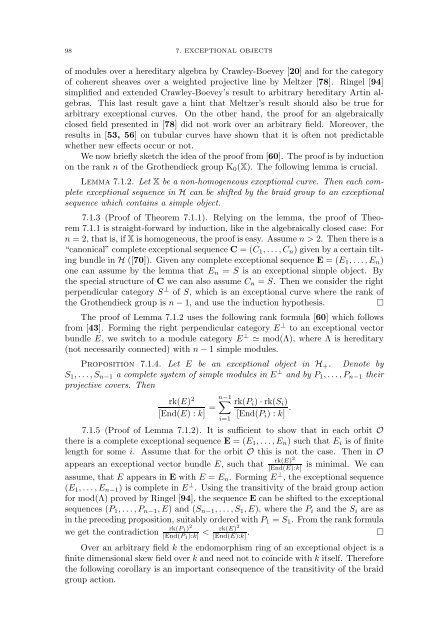MEMOIRS
MEMOIRS
MEMOIRS
- No tags were found...
Create successful ePaper yourself
Turn your PDF publications into a flip-book with our unique Google optimized e-Paper software.
98 7. EXCEPTIONAL OBJECTSof modules over a hereditary algebra by Crawley-Boevey [20] and for the categoryof coherent sheaves over a weighted projective line by Meltzer [78]. Ringel [94]simplified and extended Crawley-Boevey’s result to arbitrary hereditary Artin algebras.This last result gave a hint that Meltzer’s result should also be true forarbitrary exceptional curves. On the other hand, the proof for an algebraicallyclosed field presented in [78] did not work over an arbitrary field. Moreover, theresults in [53, 56] on tubular curves have shown that it is often not predictablewhether new effects occur or not.We now briefly sketch the idea of the proof from [60]. The proof is by inductionon the rank n of the Grothendieck group K 0 (X). The following lemma is crucial.Lemma 7.1.2. Let X be a non-homogeneous exceptional curve. Then each completeexceptional sequence in H can be shifted by the braid group to an exceptionalsequence which contains a simple object.7.1.3 (Proof of Theorem 7.1.1). Relying on the lemma, the proof of Theorem7.1.1 is straight-forward by induction, like in the algebraically closed case: Forn =2,thatis,ifX is homogeneous, the proof is easy. Assume n>2. Then there is a“canonical” complete exceptional sequence C =(C 1 ,...,C n ) given by a certain tiltingbundle in H ([70]). Given any complete exceptional sequence E =(E 1 ,...,E n )one can assume by the lemma that E n = S is an exceptional simple object. Bythe special structure of C we can also assume C n = S. Then we consider the rightperpendicular category S ⊥ of S, which is an exceptional curve where the rank ofthe Grothendieck group is n − 1, and use the induction hypothesis.□The proof of Lemma 7.1.2 uses the following rank formula [60] which followsfrom [43]. Forming the right perpendicular category E ⊥ to an exceptional vectorbundle E, we switch to a module category E ⊥ ≃ mod(Λ), where Λ is hereditary(not necessarily connected) with n − 1 simple modules.Proposition 7.1.4. Let E be an exceptional object in H + . Denote byS 1 ,...,S n−1 a complete system of simple modules in E ⊥ and by P 1 ,...,P n−1 theirprojective covers. Thenrk(E) 2 n−1[End(E) :k] = ∑i=1rk(P i ) · rk(S i )[End(P i ):k] .7.1.5 (Proof of Lemma 7.1.2). It is sufficient to show that in each orbit Othere is a complete exceptional sequence E =(E 1 ,...,E n ) such that E i is of finitelength for some i. Assume that for the orbit O this is not the case. Then in Oappears an exceptional vector bundle E, such thatrk(E) 2[End(E):k]is minimal. We canassume, that E appears in E with E = E n .FormingE ⊥ , the exceptional sequence(E 1 ,...,E n−1 )iscompleteinE ⊥ . Using the transitivity of the braid group actionfor mod(Λ) proved by Ringel [94], the sequence E can be shifted to the exceptionalsequences (P 1 ,...,P n−1 ,E)and(S n−1 ,...,S 1 ,E), where the P i and the S i are asin the preceding proposition, suitably ordered with P 1 = S 1 . From the rank formulawe get the contradictionrk(P 1 ) 2[End(P 1 ):k]
















